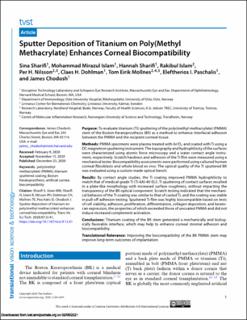| dc.contributor.author | Sharifi, Sina | |
| dc.contributor.author | Islam, Mohammad Mirazul | |
| dc.contributor.author | Sharifi, Hannah | |
| dc.contributor.author | Islam, Rakibul | |
| dc.contributor.author | Nilsson, Per | |
| dc.contributor.author | Dohlman, Claes H. | |
| dc.contributor.author | Mollnes, Tom Eirik | |
| dc.contributor.author | Paschalis, Eleftherios I. | |
| dc.contributor.author | Chodosh, James | |
| dc.date.accessioned | 2021-02-09T08:57:50Z | |
| dc.date.available | 2021-02-09T08:57:50Z | |
| dc.date.created | 2021-02-05T11:38:39Z | |
| dc.date.issued | 2020 | |
| dc.identifier.citation | Translational Vision Science & Technology. 2020, 9 (13), 1-14. | en_US |
| dc.identifier.issn | 2164-2591 | |
| dc.identifier.uri | https://hdl.handle.net/11250/2726773 | |
| dc.description.abstract | Purpose: To evaluate titanium (Ti) sputtering of the poly(methyl methacrylate) (PMMA) stem of the Boston Keratoprosthesis (BK) as a method to enhance interfacial adhesion between the PMMA and the recipient corneal tissue. Methods: PMMA specimens were plasma treated with Ar/O2 and coated with Ti using a DC magnetron sputtering instrument. The topography and hydrophilicity of the surfaces were characterized using atomic force microscopy and a water contact angle instrument, respectively. Scratch hardness and adhesion of the Ti film were measured using a mechanical tester. Biocompatibility assessments were performed using cultured human corneal fibroblasts and whole blood ex vivo. The optical quality of the Ti sputtered BK was evaluated using a custom-made optical bench. Results: By contact angle studies, the Ti coating improved PMMA hydrophilicity to match that of medical-grade Ti (Ti-6Al-4V-ELI). Ti sputtering of contact surfaces resulted in a plate-like morphology with increased surface roughness, without impacting the transparency of the BK optical component. Scratch testing indicated that the mechanical behavior of the Ti coating was similar to that of casted Ti, and the coating was stable in pull-off adhesion testing. Sputtered Ti film was highly biocompatible based on tests of cell viability, adhesion, proliferation, differentiation, collagen deposition, and keratocan expression, the properties of which exceeded those of uncoated PMMA and did not induce increased complement activation. Conclusions: Titanium coating of the BK stem generated a mechanically and biologically favorable interface, which may help to enhance corneal stromal adhesion and biocompatibility. Translational Relevance: Improving the biocompatibility of the BK PMMA stem may improve long-term outcomes of implantation. | en_US |
| dc.language.iso | eng | en_US |
| dc.publisher | Association for Research in Vision and Ophthalmology | en_US |
| dc.rights | Navngivelse 4.0 Internasjonal | * |
| dc.rights.uri | http://creativecommons.org/licenses/by/4.0/deed.no | * |
| dc.title | Sputter deposition of titanium on poly(Methyl methacrylate) enhances corneal biocompatibility | en_US |
| dc.type | Peer reviewed | en_US |
| dc.type | Journal article | en_US |
| dc.description.version | publishedVersion | en_US |
| dc.source.pagenumber | 1-14 | en_US |
| dc.source.volume | 9 | en_US |
| dc.source.journal | Translational Vision Science & Technology | en_US |
| dc.source.issue | 13 | en_US |
| dc.identifier.doi | 10.1167/TVST.9.13.41 | |
| dc.identifier.cristin | 1887067 | |
| dc.relation.project | Norges forskningsråd: 223255 | en_US |
| dc.description.localcode | Copyright 2020 The Authors tvst.arvojournals.org | ISSN: 2164-2591 1 This work is licensed under a Creative Commons Attribution 4.0 International License | en_US |
| cristin.ispublished | true | |
| cristin.fulltext | original | |
| cristin.qualitycode | 1 | |

